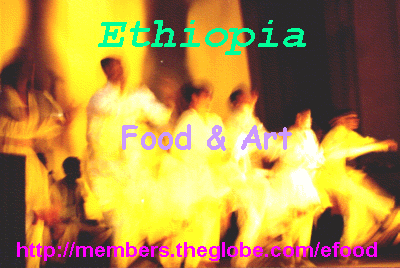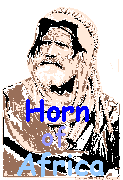Art Taste of Ethiopia
* mailing list *
new: Ethiopia, the Unknown Land: A Cultural and Historical Guide + Black Women in Antiquity (Journal of African Civilizations ; V. 6) + People of the Plow: An Agricultural History of Ethiopia, 1800-1990 + Eritrea and Ethiopia: From Conflict to Cooperation + Survival and Modernization, Ethiopia's Enigmatic Present: A Philosophical Discourse + Ethiopia: Breaking New Ground (Oxfam Country Profiles Series) + A Saint and His Lion: The Story of Tekla of Ethiopia
* maskaram
* tekemt
* hedar
* tahsas
* ter
* yekatit
* megabit
* miazia
* guenbot
* sene
* hamle
* nehase *
pwageme *
FOOD * MERKATO Index * Old HS WWW: Haile Sellassie Family Web * H.I.M. Web-Biography: from Sellassie WWW pages * R&R: Rasta & Reggae, Rastafarianism, Texts, Links, News * HISTORY: History pages from Sellassie Family Web * FAMILY: Origins, Members, Generations, Tree, photos * Ethiop Village: Books, Music, Art, Gifts * References: Sellassie WWW sites * DIRECTORIES: Listing from all Sellassie sites * appendix * contents * links * list * book * new *
Coffee
2004: "Much more could be written. About a cuisine that developed completely without sugar, and that traditionally put salt in its coffee. About a country where coffee trees still grow wild, and where they probably grew first in a province called Kefa..." writes Daniel Mesfin in the real cookbook "Exotic Ethiopian Cooking, which we cite so often. The purpose of this web-born project is to give a taste of Ethiopian culture, using its cuisine.
Well, if you want to know how real coffee tastes like, do it Ethiopian way!

If you like Turkish coffee, you would be shock by the suprimacy of Kaffe, the birth place of COFFEE!
Read about history and ceremonies -- Coffee Article
Try it at home!
Number one Ethiopian export!
* What is your favorite Ethiopian coffee?
* Leave your comments in our new "EthioCookBook"!
* How do you make it?
* Where do you buy it?
* How do you serve it?
The beverage we know as coffee emerged around A.C.E. 1000, when Arabians began roasting and grinding coffee beans and drinking the hot beverage as we do today. Until the 17th century, Arabia supplied all the world's coffee through the port of Mocha, which became one of coffee's names. Then the Dutch introduced the plant into Java, and the island quickly became synonymous with coffee.
The Coffee Drinking Ceremony
Spreading freshly cut grass on the floor sets the scene for the coffee ceremony. Traditionally, for any special occasion, scented grass will be strewn directly on the floors of houses. A recent development is to scatter flowers over the grass to make it attractive.
People take their seats around the carpet of grass and the necessary utensils for the ceremony. The lady making the coffee will sit in the centre on a stool and be dressed in a white Ethiopian dress with coloured, woven, decorative borders.
The main items needed for the ceremony include: - a black clay coffee pot, locally known as jebena which is round at the bottom with a straw lid, placed on a circular band of straw. Small, often decorated china cups, known as sini are lined up together with a sugar jug on a special wooden curved tray with four short legs, like a miniature table.
There is a narrow-waisted clay brazier for burning charcoal on which the coffee is roasted and brewed and a flat round iron pan and a spoon with a long handle for roasting the coffee beans. A small clay incense-burner and some roasted grain lie in a colourful straw basket. All together there are about forty-one items for the ceremony.
The lady who is conducting the ceremony gently washes a handful of coffee beans on the heated pan. Roasted popcorn, barley or bread is passed round, amid general conversation while the coffee beans are stirred and shaken and the husks are blown away. When the coffee beans have turned black and shining and the aromatic oil is coaxed out of them, the lady brings the pan around to every body shaking the beans so that the coffee smoke rises from the pan and gives off the strong coffee-flavoured aroma. Everybody stretches out their arms to pull the aroma closer to their noses.
The lady then brings one or two pieces of burning charcoal to the incense burner and cream-coloured incense crystals are thrown on to the burning charcoal. A few seconds later the air is filled with the smoke and aroma of the incense, mingled with the coffee smell. The Jebena, will be filled with water and placed on the brazier for boiling before the ground coffee is poured into it. At this time the lady will grind the coffee with a wooden pestle and a mortar.
Ground coffee is then added to the water in the pot little by little. With a graceful movement the lady then lifts the jebena and holding it high pours into the little cups and fills them up to the brim. Now the first round of coffee known as awol, a word of Arabic origin, meaning ‘first’ is ready to be drunk. The cups are then served, starting with the elderly first. Children are not served coffee but they will be given a handful of roasted popcorn, barley or a piece of bread, which is prepared for the ceremony. Traditionally in many parts of the country, coffee would have been served slightly salted and in some parts mixed with fresh butter, but currently it is served with sugar.
After the first round the jebena is refilled with water and there is more talking and consumption of popcorn or bread. The second round is now ready. It is weaker than the first as no further coffee has been added. This new round is called tona, from the Arabic thani, meaning ‘second’. When there are many guests and not enough cups to go round, or when it becomes difficult to remember to whom each cup belongs, a bowl of water will be brought in for rinsing the cups between rounds.
The third and final brew is made by again adding water to the original coffee, and brining it to the boil. The last brew is called baraka, which means ‘blessing’ in several languages including Arabic and Geez, the Ethiopian ecclesiastical language. At the end of the third round the elderly bless the house and everybody departs.
 Traditionally the ceremony is held on Sundays or during saints’ days when people do not have to go to work. It is also an integral part of the society and gives visitors to Ethiopia a warm welcome and an insight into a traditional part of the culture.
HIM photo-archives:
Traditionally the ceremony is held on Sundays or during saints’ days when people do not have to go to work. It is also an integral part of the society and gives visitors to Ethiopia a warm welcome and an insight into a traditional part of the culture.
HIM photo-archives:
 @2001-2004
Quotes & Thoughts:
@2001-2004
Quotes & Thoughts:

How to match picture and text:
meat
soup
preface
links
references
appendix
title
Images are from Lycos Free Gallery. texts -- later.







